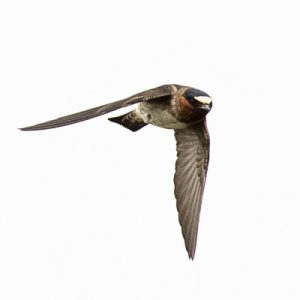
One of the avian hallmarks of spring in our region is the return of cliff swallows to nest. They delight us with their aerial acrobatics, colonial gatherings, and intricate mud nests.
Yet Santa Barbara Audubon Society (SBAS) regularly receives inquiries during the nesting season about cliff swallows and their nesting behaviors. Many of the questions come from concerned citizens who observe the physical destruction or removal of cliff swallow nests during the nesting season (which is illegal, more about this below). Other queries are from homeowners/residents who have cliff swallows nesting under their eaves and are seeking ways to prevent and/or remove the nests.

It is important to highlight that all swallows are included within the federal Migratory Bird Treaty Act of 1918 (MBTA) and, as such, are protected by state and federal regulations. The California Department of Fish and Wildlife is the state’s enforcement agency for the MBTA and considers February 15 to September 1 to be the swallow nesting season. Nests active during this time period cannot be touched, disturbed, or destroyed without a permit from the U.S. Fish and Wildlife Service. Such permits are only issued in extreme cases (e.g., nesting colony at an airport which may impact aircraft safety). Outside of these dates, the nests can be removed without a permit.
SBAS tracks nesting bird records through our Breeding Bird Study and documents local breeding activity for cliff swallows from March through August. This local data supports California Department of Fish and Wildlife’s time frame of February 15 – September 1 for the nesting season and for the prohibition of nest disturbance and destruction without a permit from the federal U.S. Fish and Wildlife Service.

The University of California Integrated Pest Management Program (UCIPM) is a resource for the public and provides (1) detailed guidance in accordance with federal and state regulations for homeowners/residents who are dealing with nesting cliff swallows and (2) strategies to discourage and prevent nest building prior to the nesting season. Specific information published by the UCIPM on cliff swallows can be accessed here. Additional guidance on nesting cliff swallows is provided by the UCIPM in their PestNotes publication.
We are privileged to witness the extraordinary natural processes of migration and breeding as the swallows return to nest and raise their young. We ask the public to respect the protective measures that have been put in place over 100 years ago to ensure the continuity of our birds for generations to come.

